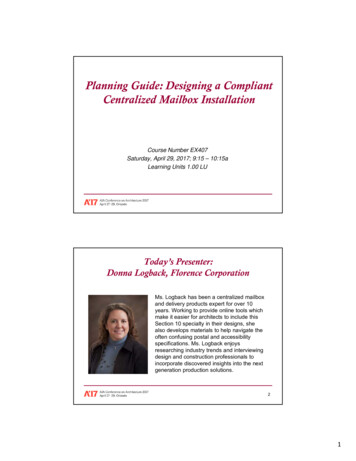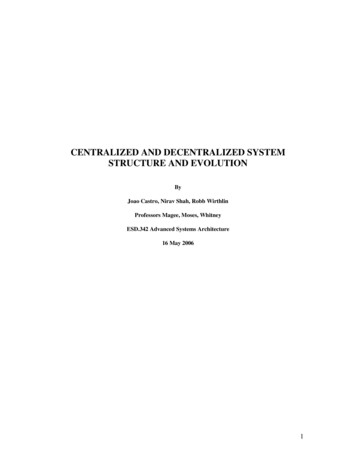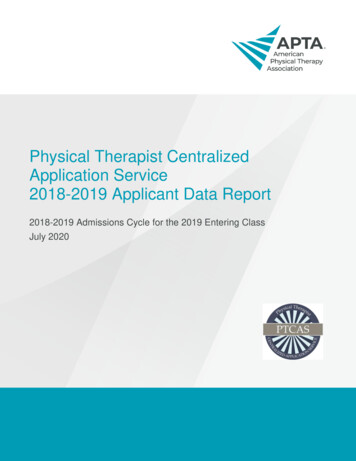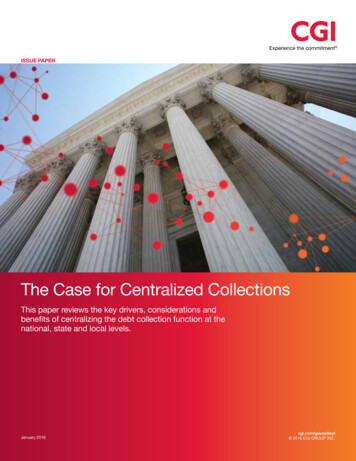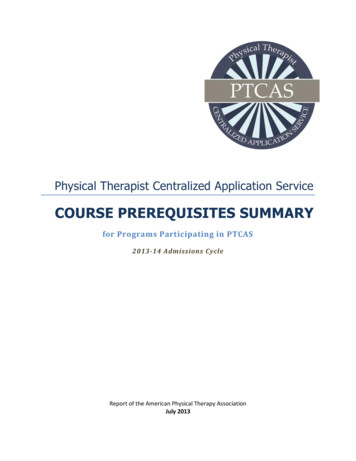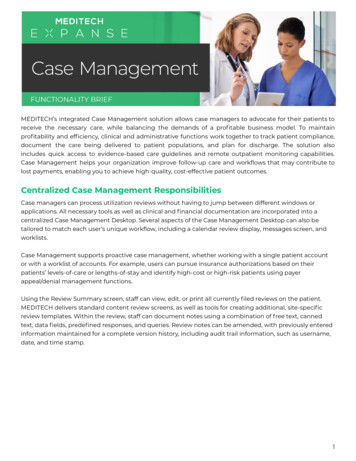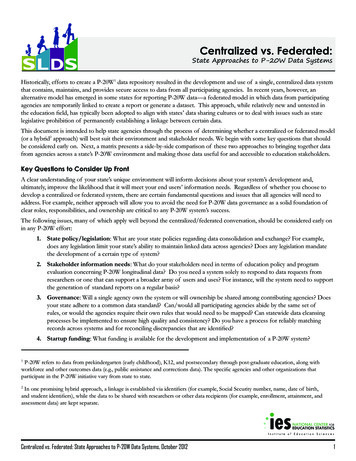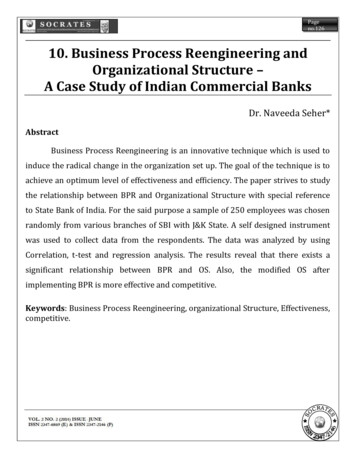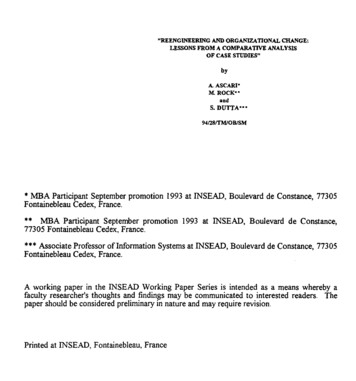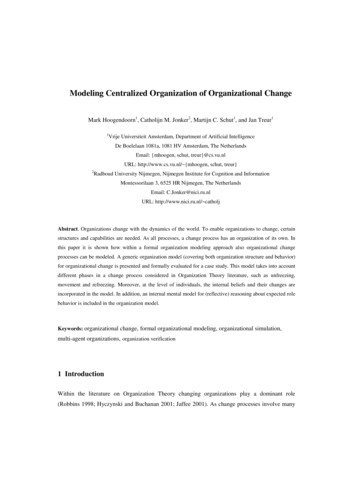
Transcription
Modeling Centralized Organization of Organizational ChangeMark Hoogendoorn1, Catholijn M. Jonker2, Martijn C. Schut1, and Jan Treur11Vrije Universiteit Amsterdam, Department of Artificial IntelligenceDe Boelelaan 1081a, 1081 HV Amsterdam, The NetherlandsEmail: {mhoogen, schut, treur}@cs.vu.nlURL: http://www.cs.vu.nl/ {mhoogen, schut, treur}2Radboud University Nijmegen, Nijmegen Institute for Cognition and InformationMontessorilaan 3, 6525 HR Nijmegen, The NetherlandsEmail: C.Jonker@nici.ru.nlURL: http://www.nici.ru.nl/ catholjAbstract. Organizations change with the dynamics of the world. To enable organizations to change, certainstructures and capabilities are needed. As all processes, a change process has an organization of its own. Inthis paper it is shown how within a formal organization modeling approach also organizational changeprocesses can be modeled. A generic organization model (covering both organization structure and behavior)for organizational change is presented and formally evaluated for a case study. This model takes into accountdifferent phases in a change process considered in Organization Theory literature, such as unfreezing,movement and refreezing. Moreover, at the level of individuals, the internal beliefs and their changes areincorporated in the model. In addition, an internal mental model for (reflective) reasoning about expected rolebehavior is included in the organization model.Keywords: organizational change, formal organizational modeling, organizational simulation,multi-agent organizations, organization verification1 IntroductionWithin the literature on Organization Theory changing organizations play a dominant role(Robbins 1998; Hyczynski and Buchanan 2001; Jaffee 2001). As change processes involve many
2Mark Hoogendoorn1, Catholijn M. Jonker2, Martijn C. Schut1, and Jan Treur1factors ranging from making the employees aware of changes to come and taking away resistanceto change to the design of efficient organizational structures. Changes can concern rather simpleprocesses of slight changes in one or more role descriptions. They may affect only a part of theorganization or practically the whole organization. Roles or big parts of the organization may bedeleted, new ones created. The realization of the organization probably changes, e.g., agentsfulfilling other roles than before, agents leaving the organization, agents joining the organization(Glaser and Morignot 1997). A change may be initiated by the environment or by the organizationitself. The organization of a change process may involve agents from outside the organization(e.g., consultation) or from inside. In this paper, the process of (business) organizational change isanalyzed in more detail. Methods used in this analysis are those of formalization, simulation andverification. To organize change processes, a generic organization model for organizational changeis introduced and formalized. This organization model incorporates both multi-agent co-operationaspects and individual cognitive aspects in the form of the internal mental states (e.g., beliefs) ofthose involved in the change.A specific area in which organizational change is inherent, is in the organization that is neededto cope with a big upcoming event. Such an event can be a planned event in the area of sports orconcerts, for example, but also an incident that can grow out to a disaster. The latter area is thefocus of the project CIM (for Cybernetic Incident Management); cf. (Abbink et al., 2004;Hoogendoorn et al., 2004; Hoogendoorn et al., 2005). A common characteristic for incidents andbig planned events is that the organizational structures start almost at zero, i.e., no activity, andhence no organization, but (have to) grow out to a scale and form of organization that is able toaddress large and complex processes by multiple parties and multiple agents. To test ideas onorganizational change modeling and to get more insight in cases with these characteristics, theorganization of a big sports event has been chosen: the famous Dutch 11 cities ice skating tour(10.000s of people all performing 200 km of ice skating on one day, going from city to city). Inthis case study the usefulness of the developed organization model for organizational change isevaluated.To model the organizational change process, the theory presented in (Lewin, 1951; Robbins,1998) has been used as inspiration, and has been evaluated on its usefulness in an operational(modeling) sense. The three phases unfreezing, moving, refreezing distinguished have beenincorporated in the generic model for organizational change developed. The case study shows that
Modeling Centralized Organization of Organizational Change3this theory indeed can be integrated in an organizational change modeling approach in a usefulmanner.This paper is organized as follows: Section 2 gives an overview of organizational changeliterature, and introduces the stages that can be identified in an organizational change process.Section 3 introduces the approach which has been used to model the stages in organizationalchange in a formal way. The model itself is specified in Section 4 both from a structural as well asfrom a behavioral perspective. Section 5 presents a language used to specify an organizationalmodel or an organization and Section 6 presents results of a case study which has been performedto show how the approach can be applied. In Section 7 formal verification is performed upon thesimulation results to show that the simulated organization indeed satisfies the desired properties.Finally, Section 8 draws conclusions based on the results presented in this paper.2 Organizational Change LiteratureOrganizational change is a well studied topic in recent literature on sociology, psychology, andeconomics. Change within organizations has become part of everyday life, some organizations areeven continuously undergoing change. Changing an organization is not a simple process, oftendifficulties are encountered within such a change process. Research has shown that over 70 percentof the change programs in organizations do not achieve the intended goal (Hall et al. 1993;Bashein et al., 1994). Boonstra (2004) criticizes typical explanations given for these failures in thatthey pay insufficient attention to the complexity of the change process itself. Three types oforganizational change are distinguished within the introduction of his book: First, plannedorganizational change, which addresses questions with respect to problems that require change intechnical and instrumental aspects in which the problems and solutions are known. Secondly,organizational development which is said to be suitable when “the changes to be made are farreaching, the problems not entirely unambiguous but still recognizable, and there is some idea asto the direction in which the solutions must be sought”. Cummings and Worley (20001) defineorganizational development as “a system-wide process of applying behavioral science knowledgeto the planned change and development of strategies, design components, and processes thatenable organizations to be effective”. The final type of organizational change distinguished istransformational change, in which the change processes include “renewal processes involving
4Mark Hoogendoorn1, Catholijn M. Jonker2, Martijn C. Schut1, and Jan Treur1actors from various organizations”. In Ackerman (1986) transformational change is said to be theemergence of a totally new state of being out of the remains of the old state.Both in planned change and organizational development an approach is taken in which a moveis performed form one stable state to another. The change processes involve the phases in which anorganization is unfrozen, changed, and refrozen. These phases within the organizational changeprocess originate from the ideas of Kurt Lewin (1951). He states that there are two opposing forcesat work when changing an organization: forces that resist the change, and forces that drive towardsthe newly desired organization. Figure 1 presents the phases and forces within organizationalchange in a graphical manner (from Robbins, 1998). The unfreezing phase begins at the momentUnfreezingDesired stateMovement RefreezingResistant forcesStatus quoDriving ForcesTimeFig. 1. Movement of an organization from a status quo to a desired state (Robbins 1998)that change becomes necessary and consists of the process of changing the resisting and drivingforces in such a way that change becomes possible (i.e., the driving forces outweigh the resistingforces). Both Schein (1993) and Hosking (1999) stress the importance of communication withinthis unfreezing phase to enable a successful change. According to Cummings (2004)organizational development has discovered a long list of causes for resistance to change, such asstructural inertia, work habits, fear of the unknown, powerful interests, and members’ securityneeds. Forces that drive an organization to change can be found in Jaffee (2001) and for exampleinclude change on the supply side, customer behavior, available technology (see e.g. Orlikowskiand Hofman, 1997), etc. The actual change of the organization is contained in the movement phasein which the organization is moved from the current state to the desired stated. The refreezingphase involves freezing the newly formed organization so that there is no possibility to return tothe former status quo or to continue changing in another unwanted direction. The whole re-
Modeling Centralized Organization of Organizational Change5organization process is completed when all phases have been completed. The unfreezing can beperformed by increasing the driving forces and/or by decreasing the resisting forces. In his book,Cummings and Worley (2001) states that Lewin’s model remains closely identified with the fieldsof planned change and organizational development.Since the model of Lewin is a highly generic model, effort in organizational developmentresearch has gone into making it more concrete. Lippitt et al. for example arrange Lewin’s modelin seven steps: within the unfreezing phase they identify scouting, entry and diagnosis. Themovement phase is split up into planning and action, and finally, stabilization and evaluation, andtermination are placed within the refreezing phase.Particularly of interest for this paper are further refinements regarding the actors withinorganizational change. Kotter (1998) has defined characteristics for change managers to preventorganizations from falling into pitfalls due to bad change management. These include havingindustrial and organizational knowledge, relations in the firm and industry, and reputation andtrack record. Power is an important aspect related to actors in organizational change processes aswell, since the resisting and driving forces of the actors need to be changed to enable anorganizational change. This particular research branch is called power dynamics. Research startedin 1946 when Kurt Lewin introduced T-groups in a laboratory training setting and was mainlybased on group-based approaches where people learn about group dynamics, leadership andinterpersonal relationships. Bradshaw and Boonstra (2004) identify several different notions ofpower. Firstly, manifest-personal power which takes the viewpoint that a person can have powerover other people and can make them do something they would not do otherwise. Researchconcerning this form of power research is said to have started with the work of Dahl (1975),Emerson (1962) and Wrong (1968). In manifest-structural power, power is no longer viewed fromthe personal perspective, but from a group perspective. Bacharach and Lawler (1980) is named asa reference for this notion of power. Negotiations are said to be an important part of the modelsregarding manifest structural power. Latent-Cultural Power sees organizing as “a process of thecreation and reproduction of shared meanings that are largely latent or unconscious”, they alsorefer to Alvesson (1993) for more details about the notion of latent-cultural power. Finally, latentpersonal power which is said to be relatively new in organization theory. This type of power issaid to differ from latent-cultural power is several different ways. First of all, power is said to bescattered throughout the organization, even individuals at the bottom of the organization can
6Mark Hoogendoorn1, Catholijn M. Jonker2, Martijn C. Schut1, and Jan Treur1deploy their power. Secondly, power relations are assumed to become part of the psyche of theindividual.As the theory of Lewin is still considered being the underlying theory for organizationalchange research and considered valid, this paper tries to model the theory in a generic sense as afirst step towards modeling and understanding complex organizational change processes. Furtherextensions might focus on the idea sketched above such as on more complex power relationships,the role of different characteristics for change managers, the different ways to enable unfreezing anorganization.3 Modeling Approach for OrganizationsBefore being able to model the organizational change processes identified by Lewin, amethodology is required which enables modeling organizations in general. This section presentssuch a methodology which allows modeling of organizations from two perspectives. First, thestructural perspective, merely specifying the structural blueprint of an organization, and secondly,the behavioral perspective which specifies the behavioral of an organization and the actors withinsuch an organization.3.1 The structural description of an organizationFor the structural description of actual multi-agent organizations, the AGR (for agent/group/role)model has been adopted (Ferber and Gutknecht, 1998). In that approach, an organization is viewedas a framework for activity and interaction through the definition of groups, roles and theirrelationships. But, by avoiding an agent-oriented viewpoin
Modeling Centralized Organization of Organizational Change Mark Hoogendoorn1, Catholijn M. Jonker2, Martijn C. Schut1, and Jan Treur1 1 . big planned events is that the organizational structures start almost at zero, i.e., no activity, and hence no organization, but (have to) grow out to a scale and form of organization that is able to address large and complex processes by multiple parties .



